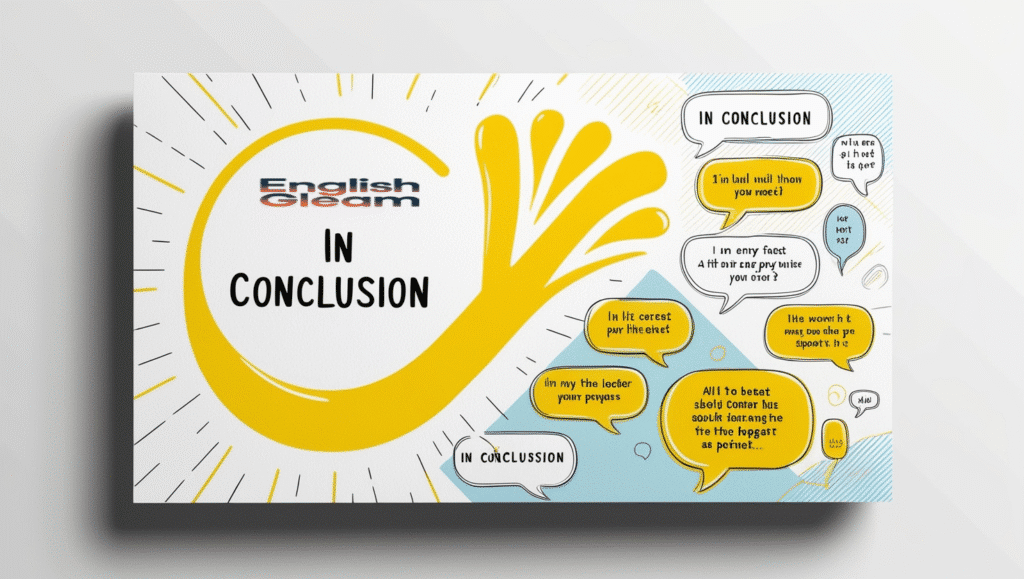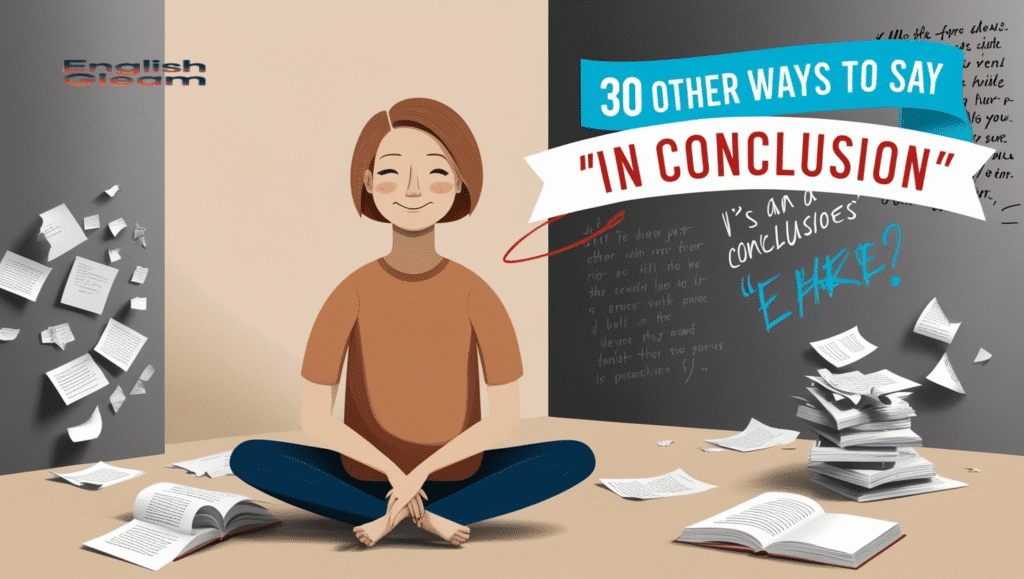There are many ways to end your writing without saying “in conclusion.” These phrases help you sound smart and clear. They make your writing more interesting and easy to read.
Tired of repeating the same old ending? Want to keep your reader’s attention until the last line? Then you’re in the right place.
This list shows 30 better ways to close your thoughts. Each one comes with an easy example. You’ll find the best match for any writing style
Quick-Glance Table of Closing Phrases
| Phrase Category | Best For | Example Use |
|---|---|---|
| Formal Writing | Academic writing, official docs | “To summarize, the data supports our hypothesis.” |
| Professional Settings | Workplace, business communication | “In closing, I recommend we launch in Q1.” |
| Conversational Tone | Informal setting, friendly blogs | “So, to wrap things up, here’s my take…” |
| Reflective Tone | Thoughtful essays, meditative pieces | “In retrospect, this project reshaped my thinking.” |
1. To Summarize
Tone: Formal, academic writing
Where: End of research paper, report
Example: “To summarize, the experiment confirmed our hypothesis with 95% confidence.”
Why you’ll love it: It’s concise and clear—and one of the strongest alternate ways to say in conclusion.
2. To Conclude
Tone: Formal
Where: End of formal essay or structured format
Example: “To conclude, our findings suggest that renewable energy investments yield long-term benefits.”
3. To Wrap Up
Tone: Conversational tone
Where: Blog posts, casual emails
Example: “To wrap up, here are the key steps you should follow moving forward.”
4. In Closing
Tone: Professional
Where: Business communication, official environment
Example: “In closing, I’d like to thank everyone for their hard work on this project.”
5. Finally
Tone: Neutral, can suit both formal and casual
Where: Reports, blog series, presentations
Example: “Finally, let’s address the question I asked at the beginning.”
6. As a Final Thought
Tone: Reflective tone
Where: Thoughtful essays, personal reflection
Example: “As a final thought, remember that the journey matters more than any destination.”
you also might like : 25 Other Ways to Say “Sorry to Bother You”
7. Last Remark
Tone: Polite expression
Where: Emails, concluded conversations
Example: “As a last remark, please note the deadline has been moved to May 30.”
8. Wrap-Up Statement
Tone: Professional
Where: Corporate meetings, strategy sessions
Example: “This wrap-up statement highlights our next steps and responsibilities.”
9. Concluding Point
Tone: Formal
Where: Academic writing
Example: “The concluding point is that social media metrics are not always reliable.”
10. Ending Note
Tone: Polite, friendly
Where: Friendly letters, blog posts
Example: “On an ending note, let me know if you want more examples.”

11. Summary Line
Tone: Structured format
Where: Reports, business documents
Example: “Summary line: Client feedback improved by 20% after implementing changes.”
12. Finally
Already covered—see #5.
We’ll skip duplicates.
13. Concluding Note
Tone: Professional
Where: Workplace gatherings, meetings
Example: “Here’s a concluding note: we must keep our momentum going.”
Also read : 25 Other Ways to Say “Thank You for Letting Me Know”
14. Final Comment
Tone: Business communication
Where: Email threads, professional discussions
Example: “My final comment: Let’s streamline the approval process.”
15. Concluding Point
Duplicate of #9.
We’ll add a new phrase:
15‑alt. In the Final Analysis
Tone: Analytical mood
Where: Evaluative pieces, data-driven conclusions
Example: “In the final analysis, the benefits outweigh the costs by 3:1.”
16. To Recap Main Ideas
Tone: Academic/Professional
Where: Workshops, corporate training
Example: “To recap main ideas: communication, collaboration, and creativity matter most.”
17. Review Points
Tone: Neutral
Where: Group meetings, review sessions
Example: “Let’s review points before we end: timeline, budget, and outreach strategy.”
18. Restate Conclusions
Tone: Formal writing
Where: Scientific papers
Example: “Restate conclusions: The new drug shows fewer side effects than the control.”
19. Overview
Tone: Formal, structured
Where: Summaries, reports
Example: “Overview: The merger will improve market position by Q3.”
20. Final Thoughts
Tone: Reflective tone
Where: End of personal essays, blogs
Example: “Final thoughts: I learned more from the challenge than I ever expected.”

21. Wrap-Up
Tone: Neutral
Where: Presentations
Example: “That’s the wrap‑up: our key achievements and next steps.”
22. Ending Summary
Tone: Neutral
Where: Reports
Example: “Ending summary: Revenue increased by 15%, but expenses rose by 10%.”
23. Concluding Statement
Tone: Formal
Where: Official documents
Example: “The following is our concluding statement: This approach reduces lead times by 30%.”
you also like : 25 Other Ways to Say “Thank You for Letting Me Know”
24. Final Note
Tone: Casual/professional; polite expression
Where: Emails, written communication
Example: “Just a final note: Don’t forget to submit your timesheets.”
25. Closing Idea
Tone: Conversational tone
Where: Presentations
Example: “Here’s a closing idea: Let’s pilot this for a month and gather feedback.”
26. Last Statement
Tone: Professional
Where: Strategy sessions, workplace gatherings
Example: “My last statement: Quality is non‑negotiable.”
27. Wrap-Up Story
Tone: Friendly manner
Where: Speeches, informal talks
Example: “As a wrap-up story: I once failed my first project—and learned resilience.”
28. Ending Thought
Tone: Reflective tone
Where: Reflective blog posts
Example: “One ending thought: Your passion fuels your success.”
29. Final Reflection
Tone: Meditative, introspective voice
Where: Journals, reflective essays
Example: “My final reflection: Empathy made all the difference in team dynamics.”
30. Last But Not Least
Tone: Polite expression with casual flair
Where: Speeches, semi-formal settings
Example: “Last but not least, thanks to all who supported this initiative.”
Pro Tips: Picking the Right Phrase
When you need to summarize key points, reflect, or close with style, choose a phrase that:
- Matches the tone—formal, professional, or casual.
- Keeps your writing fresh—avoid repeating in conclusion.
- Adds nuance—reflective tone phrases show introspection, business meetings style is more factual.
Comparison Matrix: At a Glance
| Tone Type | Phrases | Best Use Cases |
|---|---|---|
| Formal Writing | To summarize, To conclude, Concluding statement | Academic papers, official writing |
| Professional | In closing, Final comment, Wrap-up statement | Business communications, corporate docs |
| Conversational | To wrap up, Wrap-up story, So, to wrap things up | Blogs, friendly emails, speeches |
| Reflective Tone | Final thoughts, In retrospect, Final reflection | Journals, introspective articles |
🎯 How to Use These Phrases Effectively
- Know your context
- Use formal writing phrases in academic or business documents
- In business meetings, go for professional settings phrases
- In a casual environment, pick conversational or reflective phrases
- Blend them smoothly
Use natural transitions:- However, before closing,…
- For example, here’s what I learned.
- So, to conclude,…
- Keep your closing punchy
Pair a solid phrase with a strong summary or call to action.
Example: “To summarize, automating this process will save us 10 hours per week—so let’s move ahead.” - Avoid monotony
Don’t start every conclusion with the same phrase. Vary your alternate ways to keep readers engaged. - Reflect where it counts
Add personal insights or analytical viewpoints in essays, blogs, or reflective pieces.
Frequently Asked Questions (FAQs)
Q1. Why not always use “In conclusion”?
Answer: It’s clear—but it can sound stiff or repetitive. The reader might lose interest. These different expressions add warmth and nuance to your closing.
Q2. Does using fancy alternatives sound pretentious?
Answer: Not if you use them right. Stick to simple language. For instance, “To summarize” is clear and effective. Fancy vocabulary only works if it serves the message, not to impress.
Q3. What’s the difference between “To conclude” and “Finally”?
Answer:
- To conclude: Formal and structured; works well in academic writing.
- Finally: Versatile—fits formal or casual, but adds a more personal touch.
Q4. Can I mix tones (professional with conversational)?
Answer: Absolutely. A report might close with:
“In closing, I appreciate your efforts. To wrap up, here’s what’s next.”
This blends respect with friendliness—great for teams.
Q5. How long should a concluding paragraph be?
Answer:
- Aim for 2–5 sentences in formal writing, recapping key points and stating the final takeaway.
- In conversational tone, you can add a short anecdote or final insight. Just keep it under 80–100 words to maintain flow.
🔥 Final Thoughts
Using the same words again and again can make your writing feel boring. “In conclusion” is useful, but it’s not your only choice. There are many other ways to say it that sound better and fit different tones.
Whether you’re writing a report, giving a speech, or ending an email, these phrases help you sound clear and professional. Try mixing them in for a fresh and friendly tone. Your final words matter—so choose them with care.

William Jams is an experienced blogger at EnglishGleam, passionate about language, writing, and storytelling. With years of expertise in crafting engaging content, she aims to inspire readers through insightful articles that enhance their English skills and knowledge.






